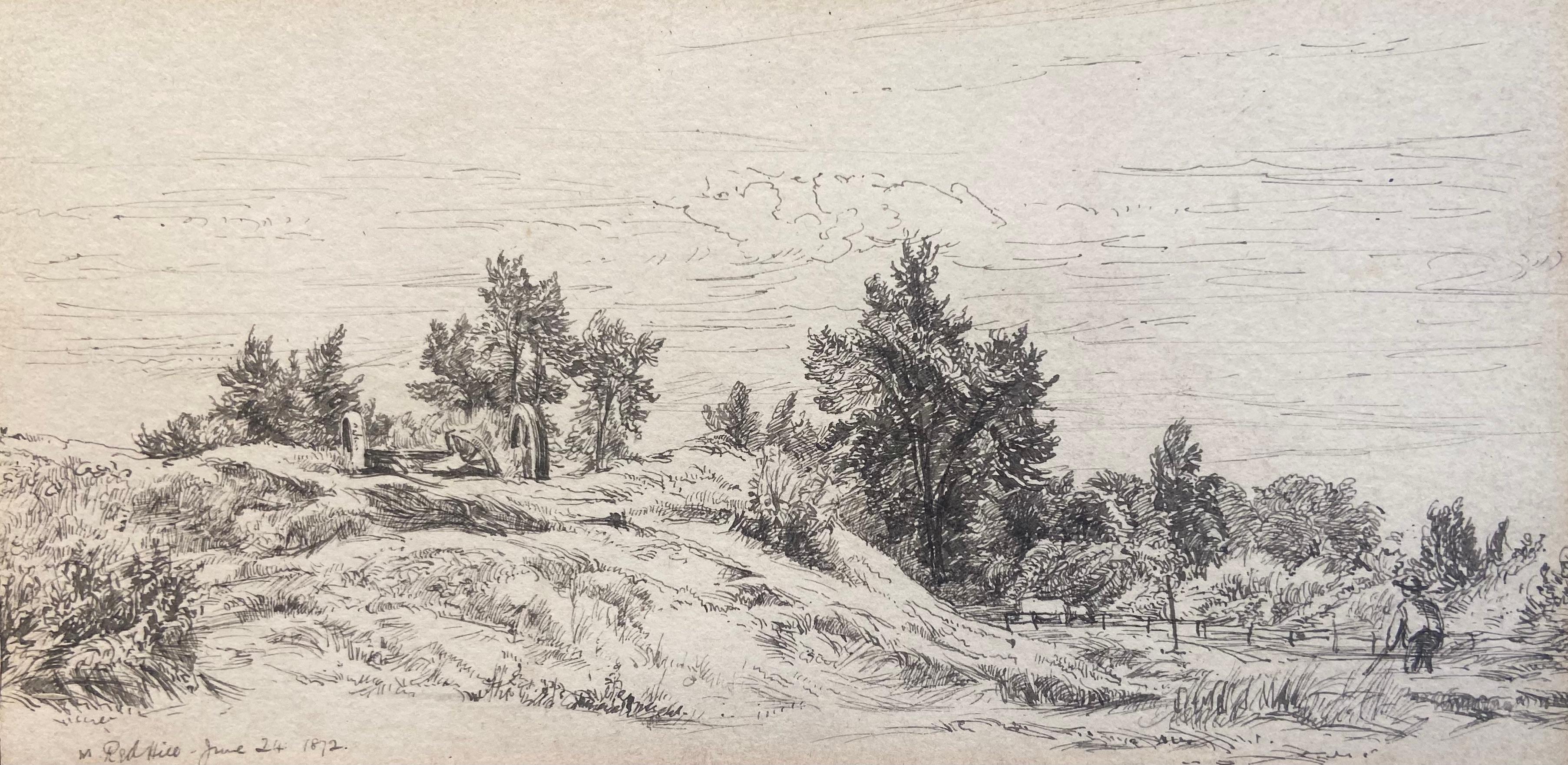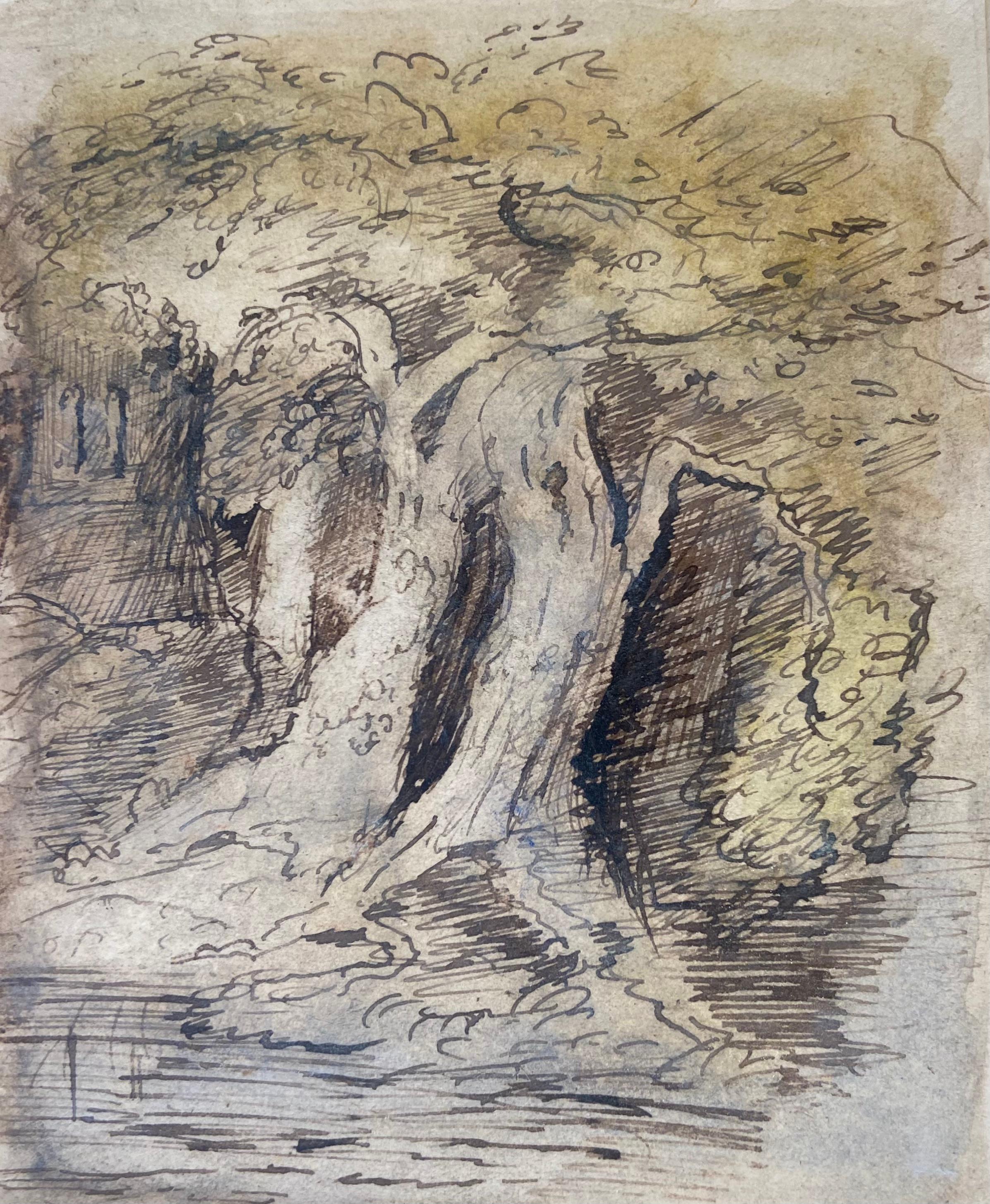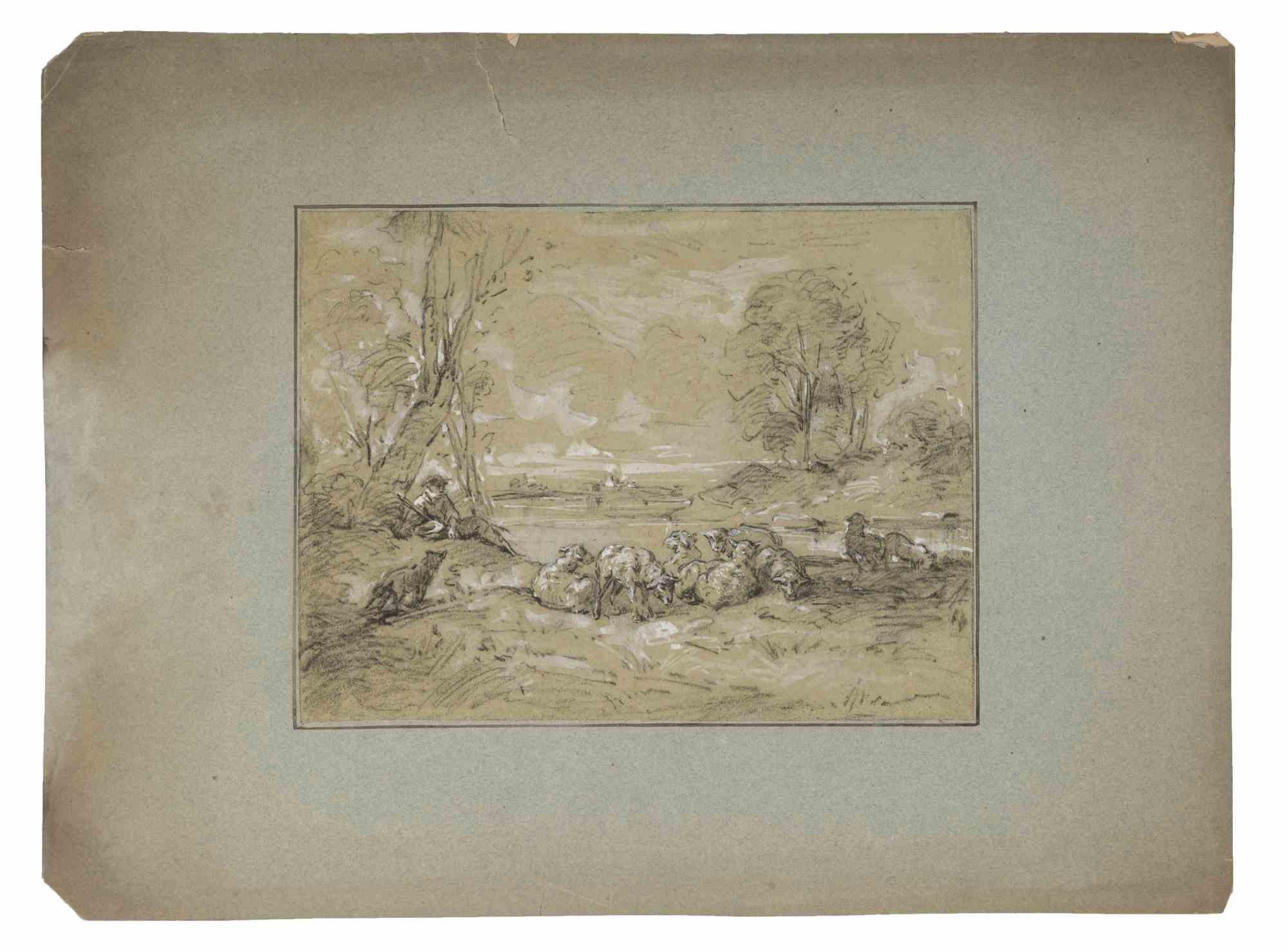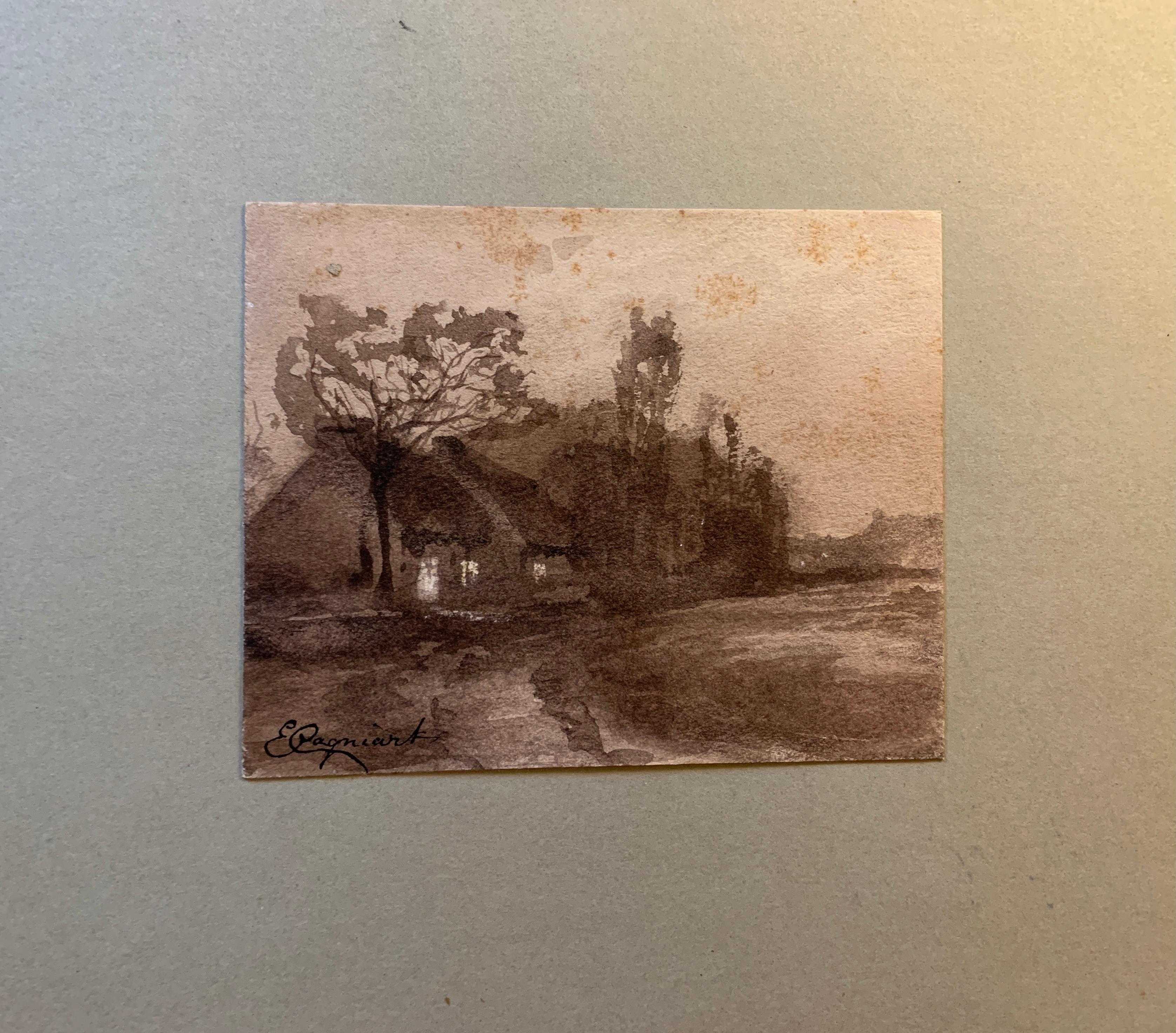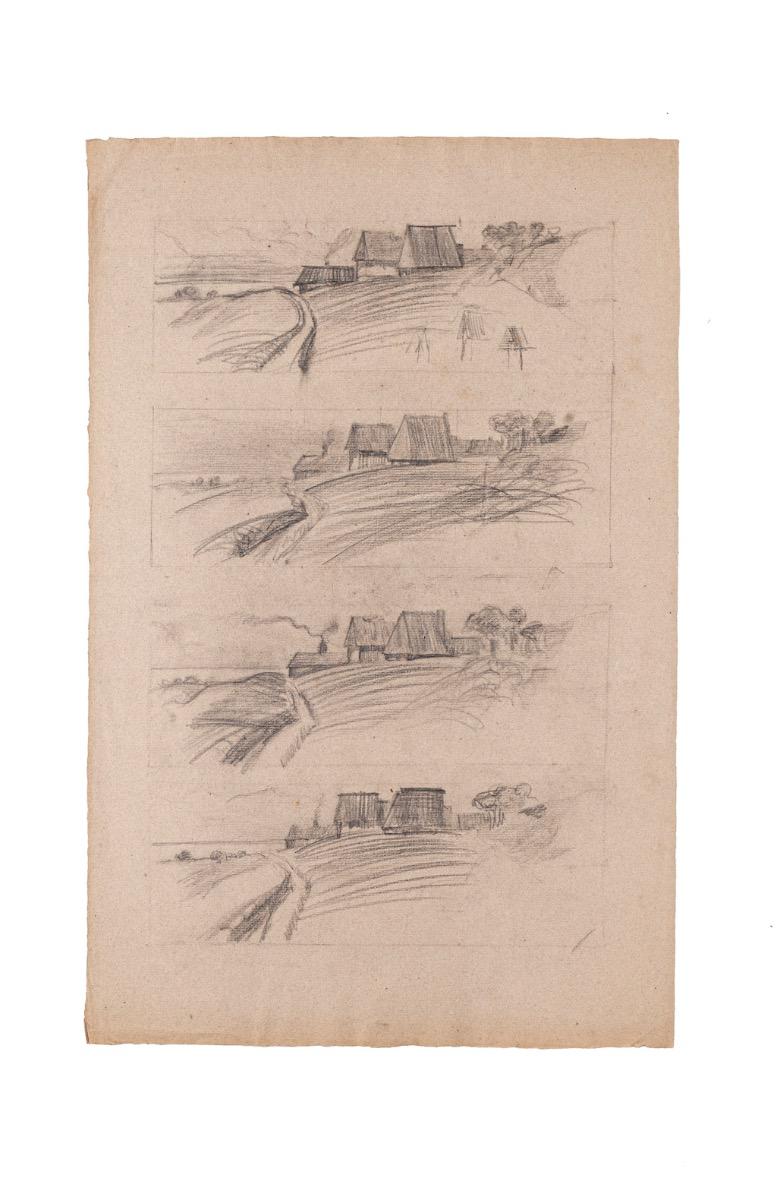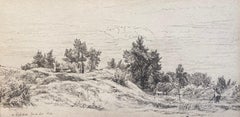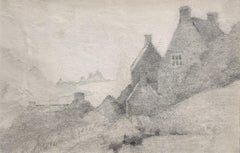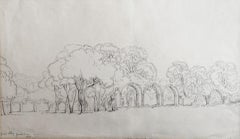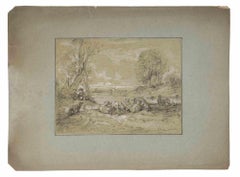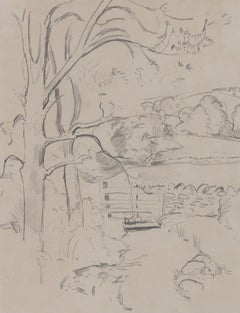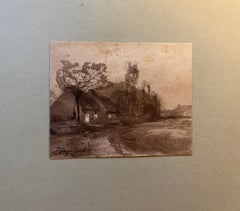Items Similar to Sketch-book Page, Shoreham, Samuel Palmer, Late 19th Century
Want more images or videos?
Request additional images or videos from the seller
1 of 4
Samuel Palmer (b.1805)Sketch-book Page, Shoreham, Samuel Palmer, Late 19th Century
$15,790.32
£11,500
€13,435.77
CA$21,926.68
A$23,927.09
CHF 12,550.17
MX$290,602.53
NOK 156,758.44
SEK 148,144.57
DKK 100,279.48
About the Item
Graphite on paper, numerous pencil inscriptions
Image size: 5 1/2 x 21 1/2 inches (14 x 55 cm)
Period style hand made gilt frame
Provenance
The collection of Ernest Pearce (1930-2012) a dedicated art collector and connoisseur of the bookplate.
This drawing, taken from one of Samuel Palmer's sketch books, depicts Mepham Barn in Shoreham. In an articulated design of the landscape, the collection of farm buildings is framed by a wooded thicket and an expansive crop field, creating a cohesive composition. Covering the double page are multiple hand-written annotations given by the artist, noting the colours and hues of the reality of the scene depicted.
Between 1825 and 1832 Palmer executed brilliant studies of the landscape around Shoreham in Kent, a small village just south of London, while he lived there. The seven years formed the artist's most fertile period during which he was able to capture an intense response to a natural harmony born of moonlight and rural scenes. Although after he left almost half a century remained to him in which to paint, he never regained the spiritual vitality of these early years.
Palmer's work at Shoreham was made in isolation, intensely personal, part of a mystical and, often, overtly religious experience, shared only with a few other people. Whilst at Shoreham, Palmer looked long and hard at his surroundings, trying to penetrate the secrets of nature, the structures, and especially the associations with his imaginary landscapes. Palmer's earliest documented visit to Shoreham was in the summer of 1826 but it is often assumed that he visited the village as early at 1824 and had a connection to the location from such an early date.
This sketch of a selection of farm buildings alludes to one of Palmer's favourite motifs in his earlier works - the primitive cottage. The inclusion of this can be found in a number of his drawings in pen and ink from the end of the 1820s. Palmer wrote in his 1824 sketchbook, 'whatever you do, guard against bleakness & grandeur and try for the primitive cottage feeling'. For Palmer, the 'pastoral essence' that he strove to capture was dependant on the primitive cottage, the harmonious interaction of man with nature and the abundance of nature.
This is a rare opportunity to purchase such a work. In 1909, many of his Shoreham works were destroyed by his surviving son Alfred Herbert Palmer, who burnt "a great quantity of father's handiwork ... Knowing that no one would be able to make head or tail of what I burnt; I wished to save it from a more humiliating fate". The destruction included "sketchbooks, notebooks, and original works, and lasted for days".
The Artist
Samuel Palmer was a British landscape painter, etcher and printmaker. He also was a prolific writer and was a key figure in Romanticism in Britain and produced visionary pastoral paintings.
Palmer was born in London, the son of a bookseller and a nurse. Palmer painted churches from around age twelve, and first exhibited Turner-inspired works at the Royal Academy at the age of fourteen. Through John Linnell, he met William Blake in 1824. Blake's influence can be seen in work he produced over the next ten years (generally reckoned to be his greatest). The works were landscapes around Shoreham, near Sevenoaks in the west of Kent. They were among the few who saw the Shoreham paintings as, resulting from attacks by critics in 1825, he opened his early portfolios only to selected friends.
After returning to London in 1835, and using a small legacy to purchase a house in Marylebone, Palmer produced less mystical and more conventional work. Part of his reason in returning to London was to sell his work and earn money from private teaching. He had better health on his return to London, and was by then married to Hannah, daughter of the painter John Linnell who he had known since she was a child, and married when she was nineteen and he was thirty-two. Palmer turned more to watercolour which was gaining popularity in England.
From the early 1860s he gained some measure of critical success for his later landscapes, which had a touch of the early Shoreham work about them – most notable is the etching of The Lonely Tower (1879). He became a full member of the Water Colour Society in 1854, and its annual show gave him a yearly goal to work towards.Palmer's later years were darkened by the death in 1861, at the age of 19, of his elder son Thomas More Palmer – a devastating blow from which he never fully recovered. He lived in various places later in his life, including a small cottage and an unaffordable villa both in Kensington, where he lived at 6 Douro Place, then a cottage at Reigate. But it was only when a small measure of financial security came his way, that was he able to move to Furze Hill House in Redhill, Surrey, from 1862.
Palmer died in Redhill, Surrey, and is buried with his wife in St Mary's, Reigate churchyard.
- Creator:Samuel Palmer (b.1805) (1805 - 1881, British)
- Dimensions:Height: 5.5 in (13.97 cm)Width: 21.5 in (54.61 cm)
- More Editions & Sizes:1 of 1 Price: $15,790
- Medium:
- Movement & Style:
- Period:
- Condition:
- Gallery Location:London, GB
- Reference Number:1stDibs: LU52412682022
About the Seller
5.0
Vetted Professional Seller
Every seller passes strict standards for authenticity and reliability
Established in 2007
1stDibs seller since 2014
84 sales on 1stDibs
Typical response time: 4 hours
- ShippingRetrieving quote...Shipping from: London, United Kingdom
- Return Policy
Authenticity Guarantee
In the unlikely event there’s an issue with an item’s authenticity, contact us within 1 year for a full refund. DetailsMoney-Back Guarantee
If your item is not as described, is damaged in transit, or does not arrive, contact us within 7 days for a full refund. Details24-Hour Cancellation
You have a 24-hour grace period in which to reconsider your purchase, with no questions asked.Vetted Professional Sellers
Our world-class sellers must adhere to strict standards for service and quality, maintaining the integrity of our listings.Price-Match Guarantee
If you find that a seller listed the same item for a lower price elsewhere, we’ll match it.Trusted Global Delivery
Our best-in-class carrier network provides specialized shipping options worldwide, including custom delivery.More From This Seller
View AllA View Near Redhill, 19th Century Pen and Ink Drawing by Samuel Palmer
By Samuel Palmer (b.1805)
Located in London, GB
Pen and ink on paper, inscribed 'Redhill' and dated 'June 24th 1872' lower left
Image size: 4 x 8 inches (10 x 20 cm)
Mounted and Framed
Provenance
Given to Ernest Pearce by Carlos Peacock, from the collection of Miss Louisa Twining (1820-1911), a pupil of Samuel Palmer.
Carlos noted in his letter accompanying the work to Ernest Pearce that 'Going through my Palmer things for mounting the other day. I found this little sketch dating from the Redhill days. Thought you might like it by way of a Christmas gift'.
Literature
Carlos Peacock, Samuel Palmer , Shoreham and After, published by John Baker 1968, illustrated on page 67.
This delicate pen and ink drawing depicts a view at Redhill, a town in the borough of Reigate within the county of Surrey, England. While Palmer's reputation rests mainly on his Shoreham work some of his later work, such as his sketches from Redhill, have recently received more appreciation.
In 1872 Palmer was living in Redhill, at his last home, The Chantry at Cronks Hill. The Chantry is now Grade II listed due to the Palmer connection and Palmer Close, a cul-de-sac in Redhill (built in the 1960's), was also named in his honour.
This work is an illustration of rural paradise, a vision of the natural world where there is a cosmic harmony between man and his environment. Indeed, Alfred Palmer, the artist's son, wrote 'Had the artist depended for his material solely on the fields, and woods, and hills around him, and had he used that material in a sordid way, he might have given us faithful representations of those he selected, but there would have been inevitable repetition, and he would never have shown us as he has undoubtedly done, the very spirit and quintessence of the loveliest and most poetic pastoral scenery - scenery which we may imagine as that of ancient England...
Category
19th Century Landscape Drawings and Watercolors
Materials
Ink, Pen
Ancient Oak Trees in Lullingstone Park, Samuel Palmer Watercolour and Ink
By Samuel Palmer (b.1805)
Located in London, GB
Watercolour and pen and ink on paper, inscribed verso
Image size: 5 x 4 inches (13 x 10 cm)
Framed
This drawing most likely depicts a view in Lullingstone Park, near the village of ...
Category
Mid-19th Century English School Landscape Drawings and Watercolors
Materials
Ink, Watercolor, Pen
View of Cornwall, Graphite Sketch, 20th Century English Female Artist
Located in London, GB
Graphite on paper
Image size: 5 1/4 x 8 inches (13 x 20.25 cm)
Mounted
Jane Ross
Little is known about Jane Ross apart from that she attended Heatherley's Art School. Here she met...
Category
20th Century English School Landscape Drawings and Watercolors
Materials
Paper, Graphite
Ruins of Hailes Abbey, 19th century landscape sketch
Located in London, GB
Graphite on buff paper
'Hales Abbey, Gloucestershire' initialled, inscribed and dated 1837 bottom left
Image size: 8 x 13 1/2 inches (20 x 34.5 cm)
18th Century Hogarth frame and was...
Category
1830s Victorian Landscape Drawings and Watercolors
Materials
Graphite
The Cemetery, Graphite Sketch, 20th Century English Female Artist
Located in London, GB
Graphite on paper
Image size: 7 x 5 inches (17.75 x 12.75 cm)
Mounted
Jane Ross
Little is known about Jane Ross apart from that she attended Heatherley's Art School. Here she met ...
Category
20th Century English School Landscape Drawings and Watercolors
Materials
Paper, Graphite
A River Landscape, 19th Century British Watercolour, Signed and Dated 1880
By Alfred East
Located in London, GB
Watercolour on paper, signed and dated '1880' bottom left
Image size: 9 x 13 inches (23 x 30 cm)
Hand made gilt frame
Sir Alfred East
Sir Alfred East was born in Kettering, Northa...
Category
1880s Modern Landscape Drawings and Watercolors
Materials
Watercolor
You May Also Like
The Landscape - Drawing in pencil on paper by Joseph Dumas Descules-19th Century
Located in Roma, IT
The Landscape is a drawing in pencil and white lead on paper realized by Joseph Dumas Descules (1813-1885).
Applied on a Passepartout 30 x 41 cm, with a cutting at the top of the Pa...
Category
19th Century Modern Figurative Drawings and Watercolors
Materials
Pencil
Landscape with Gate by Orovida Pissarro - Drawing
By Orovida Pissarro
Located in London, GB
Landscape with Gate by Orovida Pissarro (1893-1968)
Pencil on paper
25.7 x 20.4 cm (10 ¹/₈ x 8 inches)
Executed circa 1917
Artist biography:
Orovida Camille Pissarro, Lucien and Esther Pissarro’s only child, was the first woman in the Pissarro family as well as the first of her generation to become an artist. Born in Epping, England in 1893, she lived and worked predominantly in London where she became a prominent member of several British arts clubs and societies.
She first learned to paint in the Impressionist style of her father, but after a brief period of formal study with Walter Sickert in 1913 she renounced formal art schooling. Throughout her career, Orovida always remained outside of any mainstream British art movements. Much to Lucien's disappointment she soon turned away from naturalistic painting and developed her own unusual style combining elements of Japanese, Chinese, Persian and Indian art. Her rejection of Impressionism, which for the Pissarro family had become a way of life, together with the simultaneous decision to drop her famous last name and simply use Orovida as a ‘nom de peintre’, reflected a deep desire for independence and distance from the weight of the family legacy.
Orovida's most distinctive and notable works were produced from the period of 1919 to 1939 using her own homemade egg tempera applied in thin, delicate washes to silk, linen or paper and sometimes embellished with brocade borders. These elegant and richly decorative works generally depict Eastern, Asian and African subjects, such as Mongolian horse...
Category
1910s Post-Impressionist Figurative Drawings and Watercolors
Materials
Paper, Pencil
French 19th century Pen and Ink landscapes from a sketch folder
By Emile Cagniart
Located in Woodbury, CT
Interesting and well-drawn French late 19th-century landscape sketch in pen and ink .
Emile Cagniart was born in Paris where he would remain for his sixty years. Like many young asp...
Category
1890s Impressionist Landscape Drawings and Watercolors
Materials
Ink
$760 Sale Price
20% Off
Free Shipping
Landscape - Drawing in Pencil on Paper - 19th century
Located in Roma, IT
Landscape is an original drawing in pencil on paper realized by an Anonymous artist of the XIX century. With a detailed drawing of a cottage on the rear.
The State of preservation is very good with the traces of time.
Sheet dimension: 47x30.5 cm.
The artwork represents the countryside landscape in four separate drawings through intense black color, skillfully farmhouses and cottages on the hillside depicted by quick and confident strokes, showing with enchanting harmony the beauty of living in nature.
Category
19th Century Figurative Drawings and Watercolors
Materials
Etching
Landscape - Drawing - 19th Century
Located in Roma, IT
Landscape is a modern artwork realized by in the 19th Century.
Charcoal drawing.
Good conditions.
Category
19th Century Modern Figurative Drawings and Watercolors
Materials
Paper, Charcoal
$335 Sale Price
30% Off
Landscape - Drawing by Joseph Alexander Colin - Mid-20th Century
Located in Roma, IT
Landscape is a drawing realized by Joseph Colin in the Mid-20th Century.
Pencil on ivory-colored paper
Good conditions with slight foxing.
The artwork is realized through deft exp...
Category
Mid-20th Century Modern Figurative Drawings and Watercolors
Materials
Pencil, Paper
More Ways To Browse
Art And Sketch And Hands
Antique Book Pages
19th Century Victorian Cottage Paintings
Antique Drawing Book
Antique Nurses
Visionary Painting
Moonlight Scene
John Blake
Lake District Watercolour
Raphael Tuck And Sons
Tuck And Sons
Windsor Castle Watercolor
Antique English Cottage Watercolours
Boat Italy Drawing
Castle Chillon
Charles Culver Paintings
Charles De Wolf Brownell
Crashing Waves Watercolor
